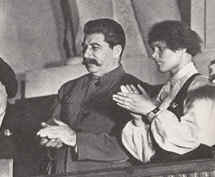Joseph Stalin lead Russia throughout World War Two and up to his death in 1953. Joseph Stalin was leader of Russia when Hitler launched Operation Barbarossa in June 1941 and saw his nation survive the battles fought at Moscow and Leningrad and oversaw a vital victory at the Battle of Stalingrad in 1942/43. It was the Russian Army that launched the final victory over Germany at the Battle of Berlin in the spring of 1945.
|
|
Stalin in 1936
What do we know about Stalin?
| • He was born in 1879
•He came from a poor background; his father was a cobbler and his mother was a peasant •His real surname was Djugashvili • He did well at school and won a scholarship to go to a seminary where priests were trained • It was at this seminary that Stalin turned to Marxism •He became a follower of Lenin and went to secret meetings and distributed leaflets • Between 1902 and 1913 he was arrested 8 times and exiled to Siberia. He escaped 7 times! • In prison, he adopted the name Stalin which translated as “Man of Steel”. He felt that it would be good for his image • He was a very good organiser and the part he played in the November 1917 Revolution was probably small. But the skills he gained while helping to organise the Bolshevik Party were to prove invaluable • After 1917, he was rewarded with a number of seemingly unimportant party positions which nobody else wanted. But they gave Stalin a perfect insight into who could be trusted to support him and who could not • Stalin was seen as dull by the intellectual elite of the Bolshevik Party. They all made a fatal mistake in assuming that he was stupid. |
When Stalin became the undisputed leader of Russia in 1929, he realised that Russia was far behind the west and that she would have to modernise her economy very quickly if she was to survive. Also a strong economy would lead to a strong military if Russia was going to survive threats from external forces. A modernised Russia would also provide the farmers with the machinery they needed if they were going to modernise their farms such as tractors.
Stalin knew that Russia needed a strong army. However, such was his fear of ‘enemies within’, that he purged the Red Army of most of its senior commanders. Only one marshal out of five was left alive and the Red Army became all but leaderless. It was a massive army but it was like a huge body with no brain to it. Hence when Hitler launched ‘Operation Barbarossa’ in June 1941, the Red Army was all but swept aside by the Wehrmacht.
Despite the Germans reaching the outskirts of Moscow, Stalin did not leave his capital and played his part in defending his country against the Wehrmacht. As Commissar of Defence, Stalin ordered those who fought in the battle at Stalingrad not to give an inch to the Germans and he was very much the leader of his nation throughout the war. Recent released records from Russia does show Stalin’s other side, however. The heroics of the people of Leningrad – besieged by the Germans between September 1941 and January 1944- was recognised by many people as a feat of huge heroism. For the duration of the siege, the city’s leaders had to make their own decisions as they were frequently cut off from Moscow and could not follow orders from Moscow. Such an independent spirit was not tolerated by Stalin and after the war, those city leaders of Leningrad during the war were dealt with by Stalin in what was effectively a second purge of those he did not trust.
During the war, Stalin met the other ‘Big Two’ – Winston Churchill and F D Roosevelt. It was at these conferences that the origins of the Cold War were sown especially as Stalin had not been invited to the meeting at Casablanca which did a great deal to arouse Stalin’s suspicions as to what the others were planning. General George Patton so distrusted Stalin that he wanted the Allies in the west of Europe to take on the Russians when it was clear that the Germans had been beaten.
Stalin was especially angered when the atomic bomb was used on Hiroshima. President Truman had told him that America had a new and potent weapon but had said no more. The massive power of ‘Little Boy’ and ‘Fat Man’ completely altered the Arms Race that Stalin’s Russia had been winning regarding conventional weaponry – few tanks could equal the T-34 while manpower was no object. The Stormavik was a well respected fighter plane as well. But all this counted for little after the devastation of Hiroshima and Nagasaki. With bomber bases easy to build in western Europe, Stalin knew that Moscow could be a potential target and he had to adapt his foreign policy accordingly.
After the end of the war, Stalin’s position in Russia had been elevated by his leadership of the nation in its time of need. He maintained an iron grip on Russia and the east European satellites Russia controlled, until his death in March 1953.
Related Posts
- The Winter War 1939 The war between Russia and Finland, generally referred to as the Winter War, lasted from November 30th 1939 to March 13th,…
- The show trials that took place in Stalin’s USSR had a very specific purpose for Stalin. The show trials were not held in secret but…
